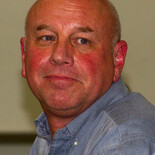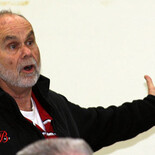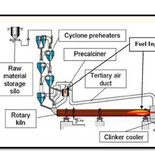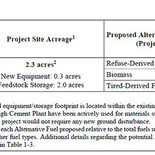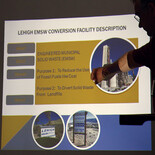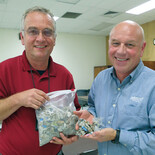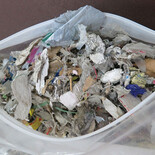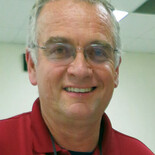Lehigh to Burn Clean Rubbish
The Forde Files No 83
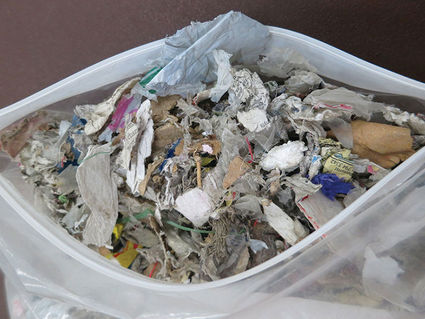
Tina Fisher Cunningham
An un-compacted sample of the treated refuse-derived fuels (RDF) that Lehigh Southwest Cement Plant proposes to begin burning in its cyclone tower and kiln during the heat-intense process of creating cement. Lehigh also proposes to burn biomass and tire-derived fuels (TDF) as alternatives to coal and coke.
An informational meeting Nov. 20 on the Lehigh Southwest Cement Plant application to use alternative fuels in the cement-making process – including treated trash, biomass and old tires – drew tough questions from residents worried about air quality.
"If this great experiment goes awry," said a person in the audience of 30 at the Kern County veterans Memorial Building, "is there insurance to compensate people?"
Another person said, "I am being treated for COPD, asthma and chronic bronchitis. When we get a bad air day, I'm pissed. I can direct that anger at you [Lehigh]."
According to Lehigh and comments from six representatives of Kern County and state regulatory agencies present at the meeting, dangerous emissions should decrease when alternative fuels are used with coke and coal.
"Testing has shown that these are lower [emissions] than traditional fuels," Craig Mifflin, manager of environmental and public affairs for Lehigh, said. "In Europe and Japan they have been using these for 30 to 40 years."
The project's Environmental Impact Report (EIR) states that the use of alternative fuels "is proposed in order to lower air pollutant and greenhouse gas emissions from the Lehigh Cement Plant and to allow the facility operator more flexibility in the sourcing of fuels to make cement."
The project also serves to divert material from landfills.
Residents were concerned largely about the prospect of tires being burned at the plant. Lehigh has asked for a permit to mix a maximum of 50 percent refuse-derived fuels (RDF), a maximum of 40 percent biomass and a maximum of 25 percent tire-derived fuels (TDF) with its traditional fuel of coal and coke. One other cement plant in Kern County uses tires for fuel, Mifflin said.
Lehigh will start its alternative fuels program using refuse-derived fuel. The company has no plan yet to use tires, he said.
"We wanted to cover our bases. That's why TDF [tires] was included in the EIR."
To a woman who pointed out that one section of the EIR said there would be "unavoidable significant impacts," Mifflin said that it referred to the construction period.
"Under CEQA (California Environmental Quality Act), any emission counts – it could be a pickup truck on the site. There's dust. There's no way to avoid it...anything over zero is a significant impact."
He said the plant has baseline data for comparison when alternative fuels are used, and the air will be tested at site by a third party certified company.
"There are huge penalties for violation," he said. "They govern us from local, state and federal standards."
Speaker Charlie Bauer, environmental health specialist for the solid waste program, Kern County Public Health Services, brought a bag of un-compacted, treated RDF for inspection. The material, which comes from a facility in Sun Valley (Los Angeles), is compacted for use as fuel. Most of it is paper scraps and film plastics (thin, like grocery bags). Recyclables and chlorinated plastics like PVC pipe are purged.
Mifflin said the Sun Valley facility that treats the refuse has been in existence since the 1980s but has fallen out of use as the biomass business has declined. The treatment company has installed a $1.2 million machine to accommodate Lehigh, which will be the only cement plant in the state to add alternative fuels to its mix.
"They bought it for us," Mifflin said of the machine. "It's brand new."
Paul Benz and his son Pickle, who own Benz Sanitation, asserted that the refuse-derived fuel would not produce high enough BTUs [measurement of heat] to be useful and that Lehigh would have to add something to reach the required threshold. Mifflin said that test results are public record and show that the heat generated exceeds 7,000 BTUs.
A resident asked why the plant is not using wind and solar power.
"We've looked at it quite a bit," Mifflin said. One large wind farm that might have provided power, he said, was not well thought out [the project at the bottom of Sand Canyon, which was not built]. Also, by community and county consensus, no wind turbines are to be built near enough the cement plant to be useful.
Solar, he said, "will generate electricity but it won't do anything for the kiln."
In answer to a question about possible co-generation of power with Edison, Mifflin explained that the fuel is used for heat, not to produce electricity. The temperature in the tower and kiln rises to 2,750 degrees Fahrenheit, he said.
"We're melting rocks," he said. "We heat limestone, silica, alumina and iron, creating a new mineral [clinker]."
The fuel is consumed in the process, becoming part of the new mineral.
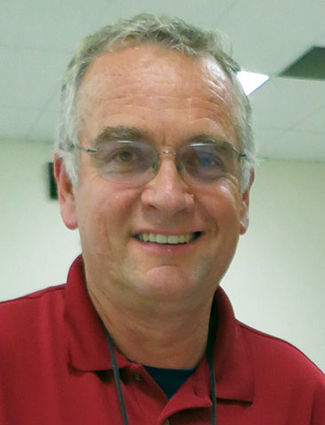
Tina Fisher Cunningham
Charlie Bauer, registered environmental health specialist, solid waste program, Kern County Public Health Services, who presided at the Nov. 20 informational meeting.
To be permitted as an Engineered Municipal Solid Waste (EMSW) conversion facility, Bauer said, the applicant must meet eight requirements: The waste will replace or supplement fossil fuels; no hazardous waste will be used; the conversion method is efficient; the waste to be converted contains less than 25 percent moisture and less than 25 percent non-combustible – that is, no rocks, bottles, heavy plastics; only seven days of waste storage is allowed and only 15 trucks per 24-hour day; no more than 500 tons a day will be converted; the waste has an energy content equal to or greater than 5,000 BTU per pound (equal to coal); the waste has to be mechanically processed at an authorized facility.
The alternative fuel facility at the plant site will take up a total of 2.3 acres – that is, 0.3 acres for new equipment and two acres for feedstock storage.
The proposal currently is being reviewed by Cal Recycle in the final step for approval, which should be accomplished by the end of January, 2015.
See http://www.CalRecycle.ca.gov for updates and read the EIR on the Kern County Department of Planning and Community Development web site (Go to "Planning Documents" on the left-hand menu, then type "Lehigh" in the search box). Mifflin said he would be happy to answer any questions about the project.


